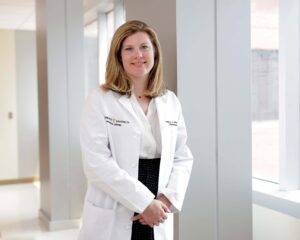On the Edge of Care

Uterine fibroids are small, a so-called ‘invisible disease,’ but they levy an outsize cost: Treatment and lost time at work across the country add up to a whopping $34 billion. That’s a lot of time and money, not to mention that 70% of women in the U.S. will develop at least one fibroid by menopause, and it is even likelier for Black women.
The full sketch of how fibroids reverberate through lives and society is bleaker once it captures the physical and mental pain that women may go through because of the fibroids, complications on pregnancy, or even the quest for diagnosis and treatment.
In a sense, uterine fibroids are exemplary of the broader state of women’s health.
Women, historically overlooked by scientific inquiry, continue to endure and live with symptoms, diseases and experiences on the fringe of care. The ripple effect persists as research uncovers more disparities. Financial pressures combined with political turmoil puts care under scrutiny and shutters some clinic and hospital doors.
Back to fibroids for a moment.
Digna R. Velez Edwards, PhD, MS, professor of Obstetrics and Gynecology at Vanderbilt University Medical Center, is filling the void. She developed a uterine fibroid polygenic risk score with data from the eMERGE Network optimized in another, separate clinical population from BioVU, Vanderbilt’s biorepository of DNA extracted from discarded blood collected during routine clinical testing and linked to deidentified medical records in the Synthetic Derivative, and validated with two other methods in another eMERGE subset of individuals.
Velez Edwards is a genetic epidemiologist specializing in women’s gynecologic and reproductive health. Her skillfulness leveraging biobanks and advanced modeling to push understanding and detection of diseases related to the uterus is striking. Few bioinformaticians are harnessing the troves of electronic health record and biobank data to look at issues characteristic of women.
“We’re just now doing genome studies, and we are behind other fields not only with genetic studies but with talking about the issues more broadly. There have been well-done review papers highlighting the evidence of us having less research, so few biomedical patents are focused on women even though women — moms — drive the family’s care,” said Velez Edwards. “Acknowledgment and research into intersectional disparities has helped the field grow.”
Tennessee women live in health care deserts
When VUMC unveiled its patient portal and accompanying My Health at Vanderbilt app, women quickly adopted it. Mapping female app users shows dots across Tennessee and Southern Kentucky. Patients of the OB-GYN service line are among the most frequent users of the app, which also includes patients receiving cancer and diabetes treatment.
In fact, two-thirds of app users have historically been women, but as overall enrollment increased, the gap between males and females shrunk.
The visualization of VUMC’s digital geographic reach is a reminder of how quickly both the academic health system and the population of the region are growing — and how far many patients are from VUMC clinics.
Many areas of Tennessee have a shortage of primary care and OB-GYN care.
In 2022, 10 Tennessee counties, including Nashville’s neighbor to the north, Robertson County, had no obstetric provider, according to the annual report to the state legislature. There are shortages of primary care and mental health providers, too, but the state flagged obstetrics as the worst.
Even in deserts, women need resources to thrive. That can be episodic prenatal, delivery and postpartum care and must include the care they need to stay healthy across their lifetime.
OB-GYN Adam Huggins, MD, MMHC, practices in Hendersonville, Nashville and Wilson County with patients traveling in from around the region and Southern Kentucky.
He’s passionate about women’s health care — his father was an OB-GYN too — and knows his patients are up against strong headwinds. With high rates of obesity, diabetes and hypertension, many need complex care, whether pregnant or not, and care might not be close by.
Food insecurity is on the rise, and inflation pressures weigh heavy on household finances, so care might get rationed or delayed. There are pervasive concerns over high-risk pregnancies or miscarriages or the ability to access treatment for other diseases under the state’s newly passed and amended law that bans abortion with a few narrow exceptions.
“The patient may be one-and-a-half hours away and not have reliable access to transportation. Smaller hospitals can struggle to make ends meet. Delivery units are very resource intensive. Any number of dozens of things can go wrong in a pregnancy. We are asking, ‘How can we bring the clinic to her?’ It’s imperative for us, as clinicians, to find ways to fill these gaps,” said Huggins, chief of staff for VUMC’s Regional Hospital Division.
He and his colleagues within the OB-GYN division are fueling an expansion. Clinics are opening around Middle Tennessee, and VUMC is partnering with regional hospitals. The health system is getting close to 9,000 deliveries across the system, with 5,200 at the flagship Nashville campus.
Countering the culture needs a new focus, more expertise
The career of cardio-obstetrician Kathyrn Lindley, MD, has been shaped by the lack of women’s health services in rural Illinois where she is from. There “is a notable absence of women’s health care,” she said. To get to an OB-GYN, women had to drive an hour out of the county.
Lindley, associate professor of Medicine, thought she would become a primary care physician with a focus on women; her sister is an OB-GYN. As she geared up for residency, she was drawn to a specialty that needed her expertise. So, she searched high and low to find someone who could train her after medical school; cardio-obstetrics didn’t have a name then.
“I struggled to find someone with the expertise. I made 15 to 20 cold calls looking for someone to help train me. Congenital heart disease had specialty care, but acquired heart disease did not, and I saw a rapidly growing need,” Lindley said.

Her whole career is devoted to cardio-obstetrics: helping the patients, bolstering the research and training a legion of recruits.
She joined VUMC in August 2022 to establish the Women’s Heart Center to integrate specialists, including OB-GYN, cardiology, mental health, nutrition, social work and nursing support, into the patients’ experience. She and her team have already submitted three grants to the National Institutes of Health.
Tennessee is among the ideal spots in the U.S. to do research and hone patient care models. Unfortunately, it’s the 11th worst for maternal mortality, and cardiovascular issues are the leading cause of maternal death. Half of the deaths are caused by hypertension with a quarter due to heart failure, Lindley said. Other issues make up the remaining quarter. Black women are more likely to die than white women from complications with pregnancy and labor.
“We have the opportunity — and it’s imperative — to focus in on those disorders, to use technology to improve access to care and treatment of hypertension with telehealth, remote monitoring and touch points that respond to the financial and logistical difficulties,” Lindley said.
The approach to women’s heart health needs a sex and gender lens that recognizes how society and family impact their ability to receive care, she said. More clinics need to be integrating the relevant specialties so women can see multiple people in one location. The realities of women’s lives need to be at the core of how care and research is structured and delivered, she said.
“There are such substantial disparities: Rural versus urban areas, Black, Native American and lower socioeconomic women are at a substantial risk of complications. We need to be doing research. I need to be training people to provide care, to influence health policy, to be a voice for those who look to us. We must educate the medical community and patients — these diseases that complicate pregnancy and impact the quality and longevity of life are increasing,” said Lindley.
Pop culture, the Super Bowl and an ‘atypical’ lens
The reality of women’s health, and the conversations around it, are part and parcel of each day for Ronald Alvarez, MD, MBA. As the chair of the Department of Obstetrics and Gynecology, his mission is to both raise awareness and boost research in women’s health while improving health outcomes step by step for the people who come to VUMC’s OB-GYN clinics.
“We’re trying to stretch ourselves across this increasing definition of what Middle Tennessee looks like. My singular focus is to make the women in the region we take care of healthier, particularly in reproductive health. We’re also looking for ways to improve health in other ways — why wait until the depression is severe? Can we be working to reduce the number of medications someone is on through preventive care or bringing in other specialties to make someone a bit healthier, even if it’s not perfect health?” said Alvarez, Betty and Lonnie S. Burnett Professor of Obstetrics and Gynecology.

Gynecology. Photo by Erin O. Smith.
Many of the questions researchers and physician-scientists are bird-dogging are stunningly obvious yet understudied because of the historical lens of ‘typical.’ Deepak Gupta, MD, recently published a JAMA Cardiology study with Loren Lipworth, ScD, that found remarkably higher risk of heart failure among both Black men and women living in rural areas.
Diseases associated more with men — cardiovascular disease, for instance — are characterized by atypical symptoms in women. Yet these are women’s health problems too, and they are increasingly common.
“We increasingly understand the response to therapies, prognosis and outcomes may differ between men and women, who are considered to have ‘atypical symptoms.’ That’s an inequitable lens because the symptoms are atypical for men but may be typical in women; but it’s men who have been more studied resulting in this bias,” said Gupta, associate professor of Medicine and director of the Vanderbilt Translational and Clinical Cardiovascular Research Center, Division of Cardiovascular Medicine.
The women’s health issues that end up in pop culture with broad buy-in on awareness get the most focus in funding and in prevention, said Lipworth, professor of Medicine and associate director of the Division of Epidemiology. Think about how pink for breast cancer awareness pops up everywhere in October — even on the NFL field.
This year, Super Bowl viewers for the first time saw an ad about menopause early in the game, putting an issue women usually only whisper about on America’s biggest prime-time stage.
The cultural discourse about what makes women healthy or unhealthy is a source of serious frustration for providers and researchers who want to improve health without being derailed by what makes headlines.
An essential element to improving health and understanding, Alvarez said, is boosting widespread recognition that “women have more diverse life phases than men, who have much fewer by comparison. Health is a longitudinal journey for a woman.”
